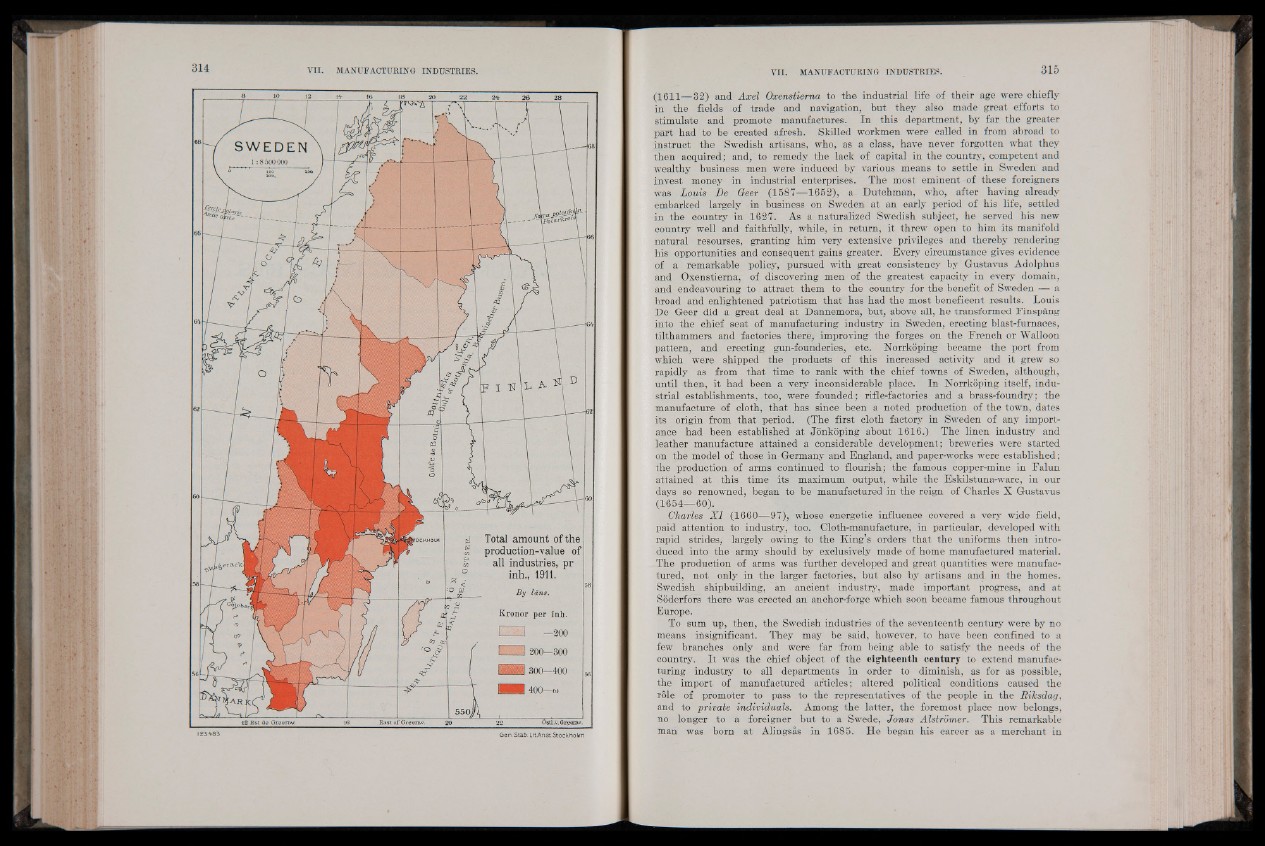
(1611— 32) and Axel Oxenstiema to the industrial life of their age were chiefly
in the fields of trade and navigation, but they also made great efforts to
stimulate and promote manufactures. In this department, by far the greater
part had to be created afresh. Skilled workmen were called in from abroad to
instruct the Swedish artisans, who, as a class, have never forgotten what they
then acquired; and, to remedy the lack of capital in the country, competent and
wealthy business men were induced by various means to settle in Sweden and
invest money in industrial enterprises. The most eminent of these foreigners
was Louis De Geer (1581— 1652), a Dutchman, who, after having already
embarked largely in business on Sweden at an early period of his life, settled
in the country in 1621. As a naturalized Swedish subject, he served his new
country well and faithfully, while, in return, it threw open to him its manifold
natural resourses, granting him very extensive privileges and thereby rendering
his opportunities and consequent gains greater. Every circumstance gives evidence
of a remarkable policy, pursued with great consistency by Gustavus Adolphus
and Oxenstiema, of discovering men of the greatest capacity in every domain,
and endeavouring to attract them to the country for the benefit of Sweden W- a
broad and enlightened patriotism that has had the most beneficent results. Louis
De Geer did a great deal at Dannemora, but, above all, he transformed Finspang
into the chief seat of manufacturing industry in Sweden, erecting blast-furnaces,
tilthammers and factories there; improving the forges on the French or Walloon
pattern, and erecting gun-founderies, etc. Norrkoping became the port from
which were shipped the products of this increased activity and it grew so
rapidly as from that time to rank with the chief towns of Sweden, although,
until then, it had been a very inconsiderable place. In Norrkoping itself, industrial
establishments, too, were founded; rifle-factories and a brass-foundry; the
manufacture of cloth, that has since been a noted production of the town, dates
its origin from that period. (The first cloth factory in Sweden of any importance
had been established at Jbnkoping about 1616.) The linen industry and
leather manufacture attained a considerable develbpment; breweries were started
on the model of those in Germany and England, and paper-works were established;
the production of arms continued to flourish; the famous copper-mine in Falun
attained at this time its maximum output, while the Eskilstuna-ware, in our
days so renowned, began to be manufactured in the reign of Charles X Gustavus
(1654— 60).
Charles X I (1660—97), whose energetic influence covered a very wide field,
paid attention to industry, too. Cloth-manufacture, in particular, developed with
rapid strides, largely owing to the King’s orders that the uniforms then introduced
into the army should by exclusively made of home manufactured material.
The production of arms was further developed and great quantities were manufactured,^'
inot only in the larger factories, but also by artisans and in the homes.
Swedish shipbuilding, an ancient industry, made important progress, and at
Soderfors there was erected an anchor-forge which soon became famous throughout
Europe.
To sum up, then, the Swedish industries of the seventeenth century were by no
means insignificant. They may be said, however, to have been confined to a
few branches only and were far from being able to satisfy the needs of the
country. It was the chief object of the eighteenth century to extend manufacturing
industry to all departments in order to diminish, as for as possible,
the import of manufactured articles; altered political conditions caused the
role of promoter to pass to the representatives of the people in the Riksdag,
and to private individuals. Among the latter, the foremost place now belongs,
no longer to a foreigner but to a Swede, Jonas Alstrdmer. This remarkable
man was bom at Alingsas in 1685. He began his career as a merchant in